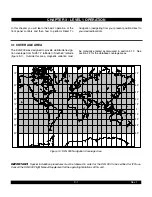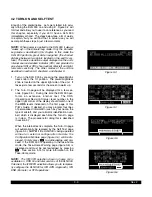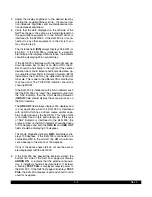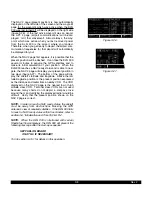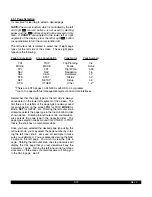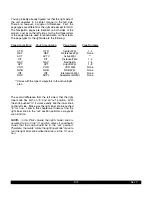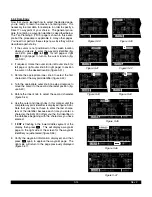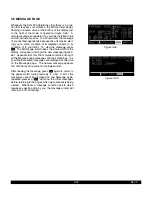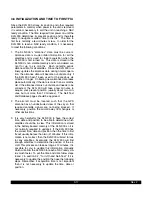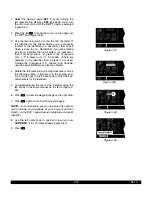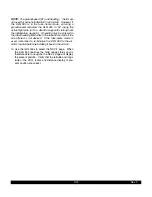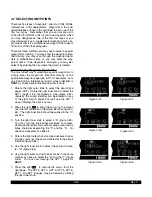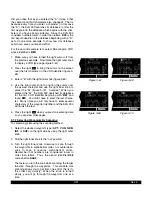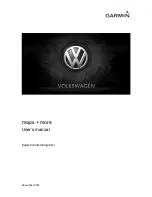
3-10
Rev 2
You might think of the page types as the chapters in a
book and the page numbers as the pages within a chap-
ter. Just as a chapter in a book may have from one to
many pages, a KLN 900 page type may have from one to
26 pages associated with it. There are, for example, 26
Flight Plan pages (FPL0, FPL1, FPL2,...,FPL25) in the
Flight Plan type and eight Airport pages (APT 1, APT 2,
..., APT 8) in the Airport type. There is one VOR page in
the VOR type.
Figure 3-33 shows another example of an Airport 4 page.
As you have previously seen, the Airport 4 page is always
used to show airport communication frequencies. Notice
the “+” sign in the APT+4 identification. Whenever a “+”
sign is part of a page identifier there will be two or more
pages, all having the same page number, used to present
all of the required information. That is, all of the informa-
tion associated with a particular page number doesn’t fit
on the page being viewed. In this case the “+” sign indi-
cates that there are two or more APT 4 pages. Figure 3-
34 shows the second APT 4 page for KMKC (Kansas
City Downtown airport).
The lower center segment (E) of the display (figure 3-31)
is used to present four different kinds of information. The
first seven spaces of this segment indicate the mode in
which the KLN 900 is operating. In figure 3-31, ENR-
LEG designates the unit is in the Enroute-Leg mode of
operation. The Enroute-Leg mode is the normal mode of
operation. The OBS mode is described in section 5.9 and
the approach modes are described in chapter 6. Lastly,
the Oceanic (OCN) mode is described in chapter 9.
The last three spaces of segment (E) are usually blank
but may contain the characters MSG or ENT. The char-
acters MSG in figure 3-35 indicate that there is a mes-
sage to be viewed on the Message page - accomplished
by pressing
M
. The characters ENT will flash in these
spaces when it is necessary to press
E
to complete
various kinds of operations (figure 3-36).
Segment (E) is also used as an area for displaying short
operational messages to the user called “status line mes-
sages”. These messages are displayed for approxi-
mately five seconds, then this segment returns to its pre-
vious display. An example of a status line message is
shown in figure 3-37. A complete listing of status line
messages is contained in appendix C of this Pilot’s
Guide.
| KMKC
|APR 119.00
|DEP 119.00
|
|
|
APT[4
PRESENT POS|=KHIF
|CLR 124.10
OGD 122^fr |GRND 121.60
8.2nm |TWR 126.20
N 41^07.60'|APR 121.10
W111^58.30'|DEP 121.10
NAV 2 enr-leg
msg
APT 4
DIS 34.5NM|DATE/TIME
+++++j+‚⁄++| 03 AUG 99
OBS IN ---^|16:28:24UTC
OUT 315^|ALT 1200ft
RMI 130^|BARO:30.02"
ANNUN ON|
APPROVE?
enr-leg ent
CRSR
; 1 KMKC |
< 2 BUM |
3 OSW |ENTER REF
4 TUL |WPT:
ABC
5 KTUL |
|
FPL 0
NO SUCH WPT
REF
Figure 3-34
Figure 3-35
Figure 3-36
Figure 3-37
| KMKC
|ATIS 120.75
|PTAX 121.90
|GRND 121.90
|TWR 133.30
|UNIC 122.95
APT[4
Figure 3-33
Summary of Contents for KLN 900s
Page 1: ...Pilot s Guide KLN 900 Global Positioning System ORS 01 02 and 04 ...
Page 3: ...ii Rev 2 THIS PAGE INTENTIONALLY LEFT BLANK ...
Page 57: ...3 30 Rev 2 THIS PAGE INTENTIONALLY LEFT BLANK ...
Page 89: ...3 62 Rev 2 THIS PAGE INTENTIONALLY LEFT BLANK ...
Page 103: ...4 14 Rev 2 THIS PAGE INTENTIONALLY LEFT BLANK ...
Page 132: ...5 25 Rev 2 THIS PAGE INTENTIONALLY LEFT BLANK ...
Page 157: ...5 50 Rev 2 THIS PAGE INTENTIONALLY LEFT BLANK ...
Page 170: ...6 13 Rev 2 THIS PAGE INTENTIONALLY LEFT BLANK ...
Page 189: ...8 4 Rev 2 THIS PAGE INTENTIONALLY LEFT BLANK ...
Page 191: ...9 2 Rev 2 THIS PAGE INTENTIONALLY LEFT BLANK ...
Page 193: ...Rev 2 THIS PAGE INTENTIONALLY LEFT BLANK A 2 ...
Page 201: ...Rev 2 THIS PAGE INTENTIONALLY LEFT BLANK B 8 ...
Page 213: ...Rev 2 THIS PAGE INTENTIONALLY LEFT BLANK E 2 ...
Page 223: ...Rev 2 I 6 THIS PAGE INTENTIONALLY LEFT BLANK ...






